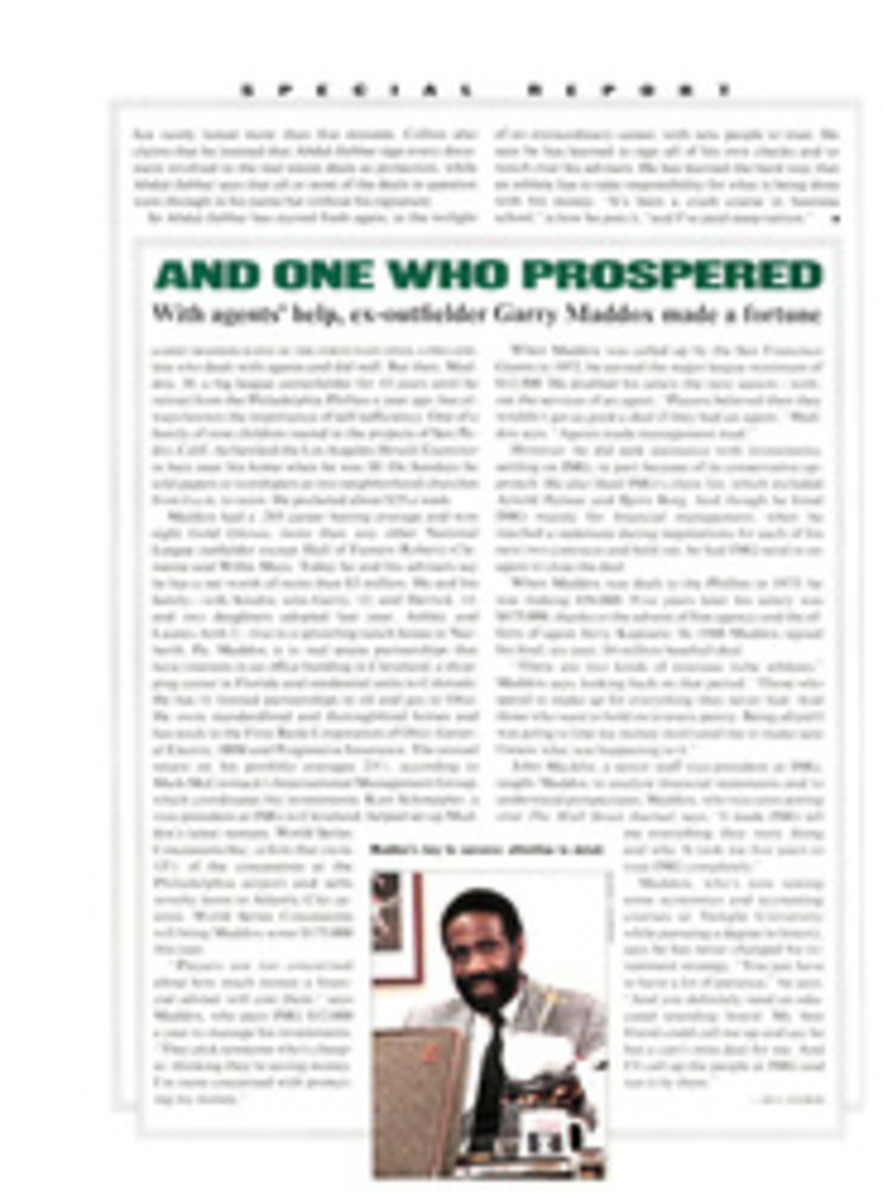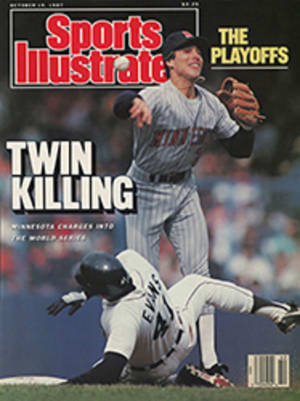
BASEBALL'S HELPING HAND
When Ralph Branca—yes, the same guy who gave up the homer to Bobby Thomson—first broke into the major leagues in 1944 as a flamethrowing 18-year-old off the NYU campus, he was paid $400 a month. At the time, he thought he had landed on easy street. Today, Branca, 61, is a successful insurance executive in White Plains, N.Y., and the president of the Baseball Alumni Team (B.A.T.), which was formed in 1986 as a financial assistance project for needy former major league players and umpires.
Big contracts and a strong pension plan became integral parts of the game in the 1970s, but there was little left over for players from previous generations. Baseball's pension program—as good as that in any industry—has provided only limited coverage for many of the old heroes. Those whose playing days ended before the 1947 season were shut out altogether.
For years the commissioner's office, the players' union and the owners knew that many players from the $400-a-month era were not living on easy street. Stories regularly came through the baseball grapevine about proud men barely able to pay their rent or cover their medical expenses. A few were given help, but there was no formal mechanism for assistance. For their part, the former players couldn't get themselves organized. In recent years, they splintered into several groups, each with its own agenda for trying to get a little piece of the rich new pie.
But in late 1985, commissioner Peter Ueberroth, realizing that baseball was facing a potential decrease in television revenues, sought an infusion of corporate cash. In addition to creating greater financial stability for the game, Ueberroth's efforts also had an unexpected benefit: They were the genesis of B.A.T.
Borrowing a stratagem he had used as president of the financially successful Los Angeles Olympics in 1984. Ueberroth invited companies to become official sponsors of Major League Baseball. The plan was for companies to put up $5 million in licensing fees, promotional efforts, advertising and appropriate product contributions. In return, they could use their official sponsor status to promote their products, just as Olympic sponsors had done.
Ueberroth's idea worked. In 1986, five companies—Arby's, Fuji Photo Film, IBM, Chevrolet and The Equitable Life Assurance—contributed an estimated $25 million to baseball in the form of promotional programs and direct assistance to teams. This year, USA Today replaced Arby's.
One of the important parts of Ueberroth's plan—and the one that provided the inspiration for B.A.T.—required each sponsoring company to make a charitable contribution to organizations of particular interest to the baseball community. So in early 1986, executives from The Equitable, along with representatives from the commissioner's office, held a brainstorming session and came up with the idea of sponsoring an old-timers' series—26 games, one in each major league park. The two- to four-inning exhibitions would feature many of baseball's greatest names and be played before regularly scheduled games. The kicker would be that The Equitable would donate $10,000 per game to an emergency assistance fund for needy former players, with smaller amounts contributed by other firms.
Before the plan could be implemented, two problems had to be overcome. The first was getting all 26 owners to agree to host an Equitable Old-Timers Game. Some teams, like the Dodgers, Yankees and Mets, already had their own old-timers' games. Other teams, like the Mariners, didn't have enough famous old-timers to hold such a game. But with a bit of 11th-hour persuasion by Ueberroth, every team agreed to participate in the series, which began last season. The Dodgers, for instance, held their usual old timers' game and fielded two teams of former Dodgers, under the banner of The Equitable. The Mariners added players to their team from an All-Star team put together by Equitable.
"It may be the only time in history that all 26 owners have agreed on something," said Ueberroth. "It was hard for them not to. The series benefits the owners, the fans, the ex-players."
As part of its commitment, The Equitable volunteered to make the arrangements for the games, including lining up the players, paying appearance fees (as much as $1,000 per player) and providing travel and hotel expenses. The players were guaranteed first-class treatment. More than 800 players have participated in the 52 games so far.
The second problem was establishing a means for distributing the money donated by The Equitable. After another meeting between the company and the commissioner's office, B.A.T. was born. It was set up as a charitable foundation, not a pension fund, with all overhead and administrative costs to be covered by the commissioner's office. In other words, every penny of the $260,000 would go directly to the former players for emergency financial help.
Assistance from B.A.T. is open to anyone, regardless of age, who has ever played or umpired in a major league game, a group that includes about 4,500 people. A 17-man board of directors reviews applications for assistance. The directors include president Branca and vice-presidents Joe Garagiola, Bob Gibson and Rusty Staub, plus 10 other former players, 1 current player and 2 representatives from The Equitable. Branca was named president (an unpaid position) because of his experience as an insurance broker and pension consultant. Frank Slocum, a writer who was an assistant to commissioner Ford Frick in the '60s, is the executive director.
Information about the organization is circulated to all former players through a B.A.T. newsletter mailed by the organization but paid for by the commissioner's office. If a player wants assistance he can apply to B.A.T. but the organization also hears from concerned friends of beleaguered ballplayers and will look into helping someone who hasn't come forth himself.
By becoming the organization's president, Branca renewed his close association with baseball after a long absence. When he retired in 1956, he went straight to work in the insurance business and has been there ever since, while living the good life with his wife, Ann, in Rye, N.Y. Before B.A.T., Branca's only regular involvement with the game was through yearly visits to the Dodgers' spring training camp and through his son-in-law Bobby Valentine, who's now manager of the Texas Rangers.
"He's in it up to his ears now," says Valentine. "Every time I call him, he's off to a board meeting, or to a meeting at the commissioner's office, or something to do with the project. I couldn't even get him out to play golf last off-season."
For Branca, it's a labor he does for love. "There are ex-players out there whose lives have taken some bad hops," he says from his office at the National Pension Service. "We are trying to provide discreet and meaningful help to these men, doing it in the spirit of friendship rather than charity."
The only reminder in his office of his 12-year pitching career (88 wins, 68 losses) is a painting of Ebbets Field. That bitter moment at the Polo Grounds on Oct. 3, 1951, when Thomson's homer beat the Dodgers for the National League pennant, still comes back to haunt him, but he hopes that won't always be the case. He says, "Today, when children read about the home run, that's all they know me for. People who saw me pitch remember I was pretty good—no, a helluva pitcher. It does get tiresome. Maybe B.A.T is a chance for people to remember me for something besides the home run."
Branca has his own special memory of pitching in the Polo Grounds. It was his major league debut on June 12, 1944. Five days before, he had been at NYU, and now he was coming on in relief for the Dodgers against the Giants. The first three hitters to face him were Buddy Kerr, Bill Voiselle and Johnny Rucker. Not exactly Murderer's Row, but then, Branca was only a teenager. And how did he do? Three up, three down, all on strikes. He looked like a bargain at $400 a month.
Now, 43 years later, Branca is the guy who signs the checks B.A.T. issues to former players. He admits to having choked back a few tears as he listened to the gratitude of some of the nearly 40 men B.A.T. has helped. "We expect to assist a lot more in the future," he says. "We've found that some of these men have too much pride to step forward and ask for help. But one of the things we guarantee in this program is that we do it discreetly. We won't reveal names. The public will never know who these players are. In fact, we use code letters and numbers on the files. The three vice-presidents, Frank Slocum and I are the only ones who know who is getting the money."
So far, according to Branca, the money has been issued for a variety of needs including hospital bills, overdue mortgage payments, funeral expenses and plain day-to-day survival. A committee is also investigating entrepreneurial ventures to increase the fund because, despite The Equitable's contributions, the total money available annually to more than 4,000 former ballplayers is less than the $400,000 average yearly salary of one current major leaguer. B.A.T. is also exploring the possibility of establishing a job placement program and a retirement home for ballplayers.
The Equitable is quite pleased with the way things are going with B.A.T. "We are proud to be able to give back something to some of these men who have given us so much," says Bill McCaffrey, executive vice-president of the company. "I feel like a kid in a candy store when I attend the old-timers' games and see so many of my heroes."
The old-timers' series has been a big hit with the fans—the games have drawn an average of 33,035 fans over the last two seasons—and with the players. "These old-timers' games have taken on a new meaning for me," says Branca. "It's the same with everybody I talk to. For one thing, there's just something special about the camaraderie in a baseball locker room. It doesn't happen in an insurance office. These games give us the chance to recapture that feeling. It's great for the spirit when the fans cheer for us, letting us know that they still remember. But more important, these games are raising money to help some men who really need it."
PHOTO
LANE STEWART
B.A.T. men (from left): Slocum, Staub, Garagiola and Branca.
PHOTO
UPI/BETTMANN NEWSPHOTOS
Thomson got all choked up when he ran into Branca at the '51 Series.
PHOTO
UPI/BETTMANN NEWSPHOTOS
A dejected Branca (far right) leaves the mound after Thomson's historic home run.
Larry Colton, who pitched two innings in the majors in 1968, now lives in Portland, Ore.

